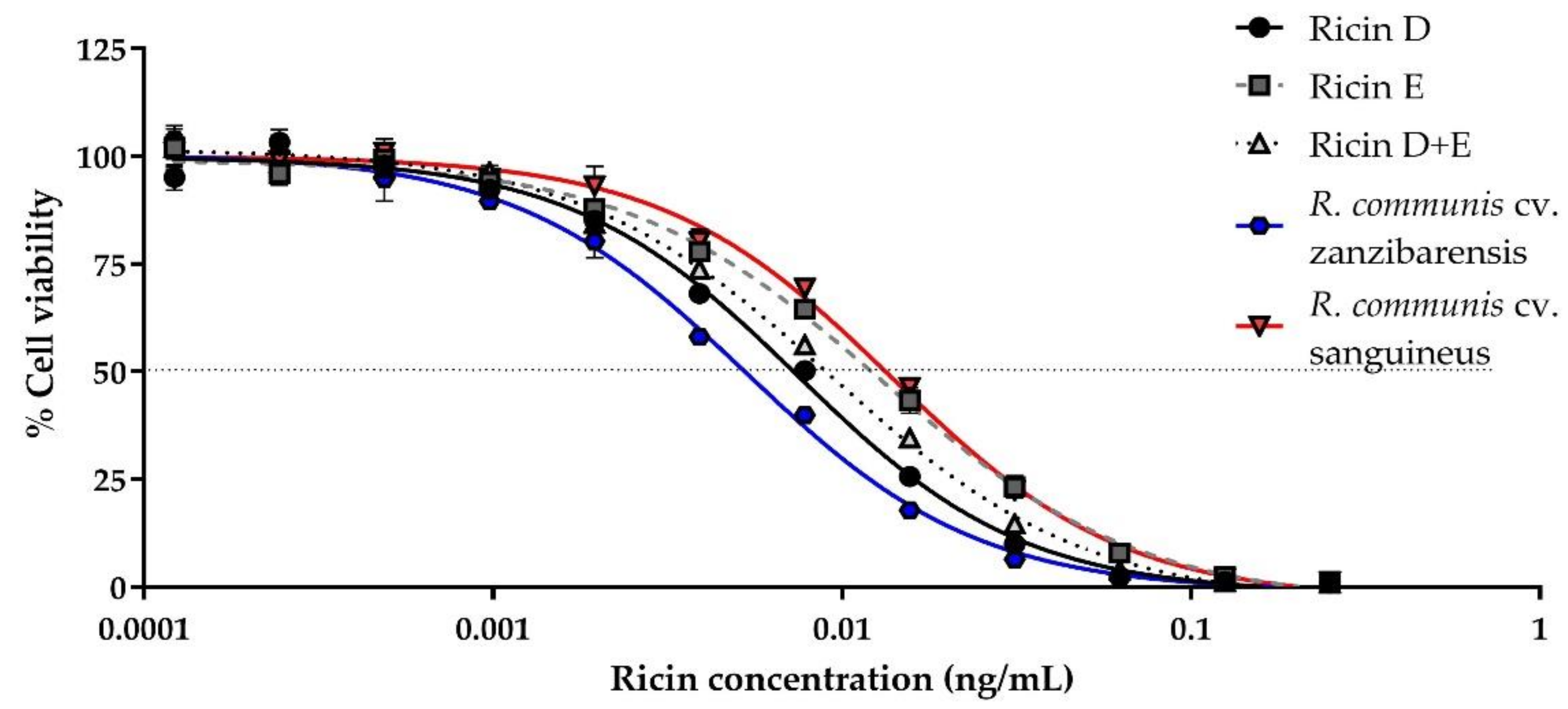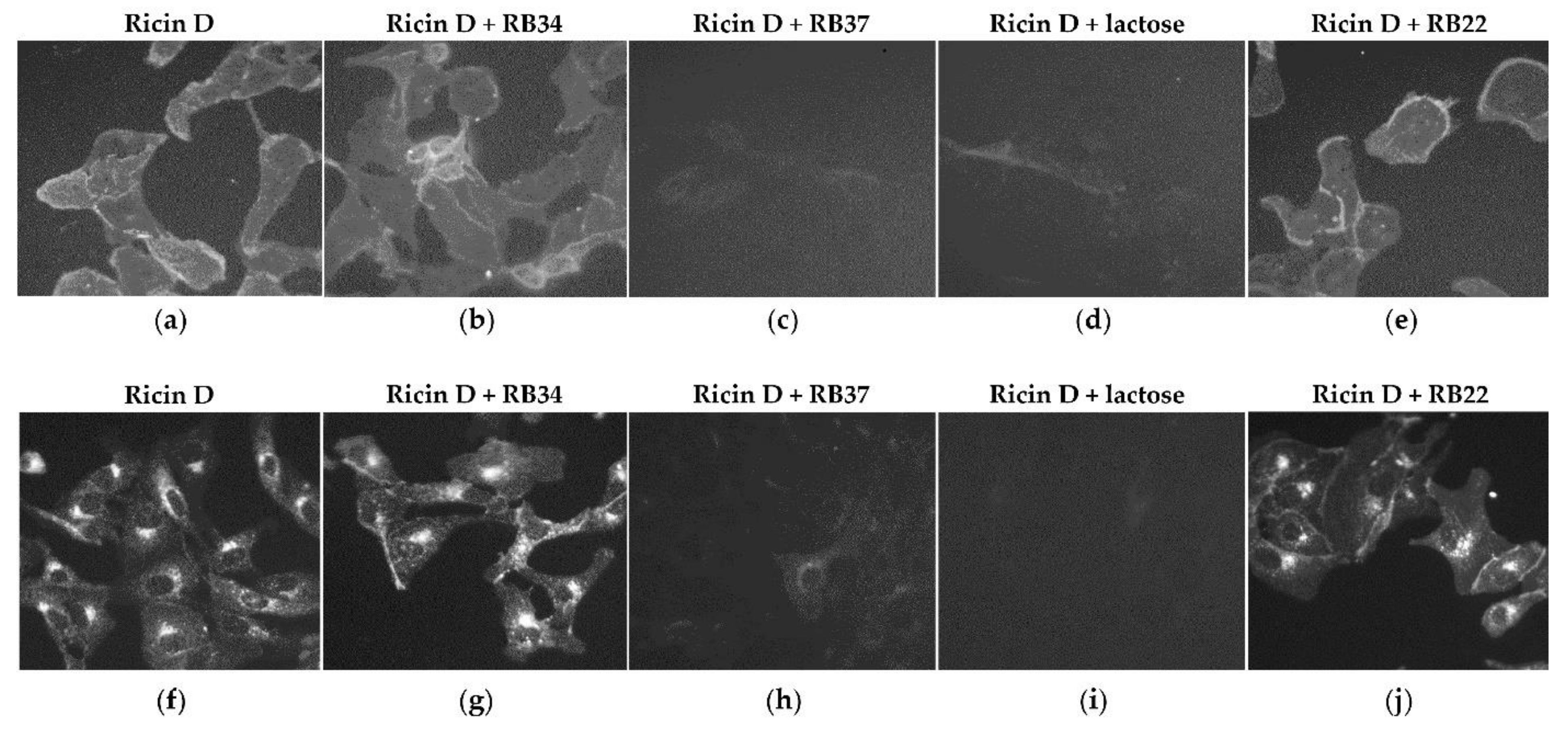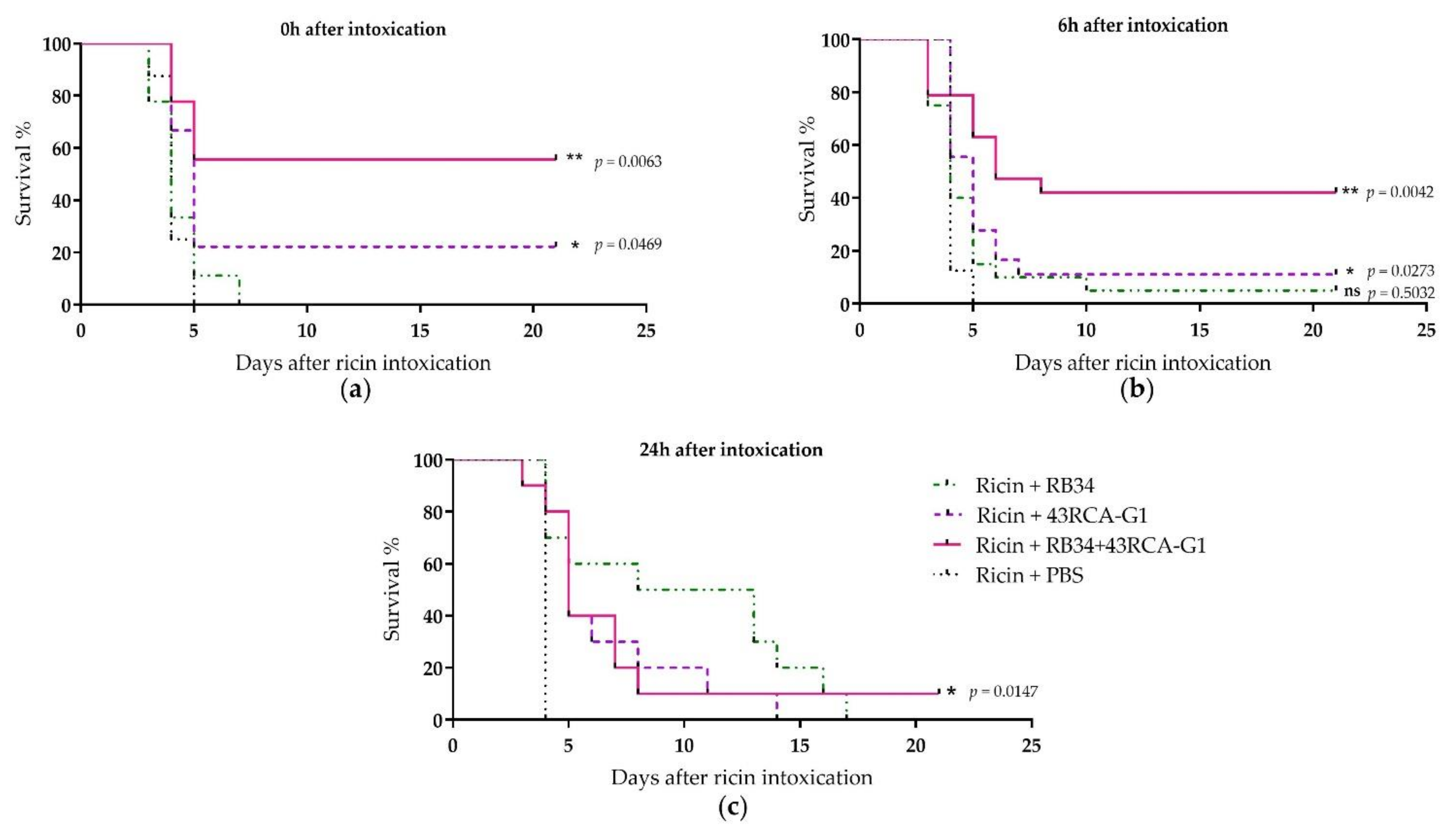Ricin Antibodies’ Neutralizing Capacity against Different Ricin Isoforms and Cultivars
Abstract
1. Introduction
2. Results
2.1. Assessment of In Vitro Cytotoxicity of Different R. Communis Cultivars and Ricin Isoforms
2.2. Kinetic Parameters of Ab Interaction with Ricin Isoforms D and E
2.3. In Vitro Neutralizing Capacity of the Abs
Ricin-Neutralizing Mechanism of the Anti-RTB mAbs RB34 and RB37
2.4. In Vivo Protective Capacity of the Abs
2.4.1. Pharmacokinetic Studies of the Abs RB34 and 43RCA-G1
2.4.2. In Vivo Protective Effect of the Abs RB34 and 43RCA-G1, Separately or in Combination
3. Discussion
4. Materials and Methods
4.1. Ricin Extracts
4.2. Recombinant and Monoclonal Abs
4.3. Cell Viability Assays
4.4. Determination of Abs/Ricin Kinetic Parameters
4.5. Fluorescent-Ricin Cell-Binding or Cell-Internalization Test
4.6. Animal Experimentation
4.6.1. Ethics Statement
4.6.2. Mice
4.6.3. Pharmacokinetics of Abs
4.6.4. Ricin D+E LD50 Determination
4.6.5. Antibody Treatment
4.7. Statistical Analysis
Supplementary Materials
Author Contributions
Funding
Institutional Review Board Statement
Informed Consent Statement
Data Availability Statement
Acknowledgments
Conflicts of Interest
References
- Sandvig, K.; Olsnes, S.; Pihl, A. Kinetics of binding of the toxic lectins abrin and ricin to surface receptors of human cells. J. Biol. Chem. 1976, 251, 3977–3984. [Google Scholar]
- Olsnes, S.; Pihl, A. Inhibition of peptide chain elongation. Nature 1972, 238, 459–461. [Google Scholar] [CrossRef]
- Endo, Y.; Tsurugi, K. RNA N-glycosidase activity of ricin A-chain. Mechanism of action of the toxic lectin ricin on eukaryotic ribosomes. J. Biol. Chem. 1987, 262, 8128–8130. [Google Scholar]
- Franke, H.; Scholl, R.; Aigner, A. Ricin and Ricinus communis in pharmacology and toxicology-from ancient use and “Papyrus Ebers” to modern perspectives and “poisonous plant of the year 2018. Naunyn. Schmiedebergs. Arch. Pharmacol. 2019, 392, 1181–1208. [Google Scholar] [CrossRef]
- Worbs, S.; Köhler, K.; Pauly, D.; Avondet, M.A.; Schaer, M.; Dorner, M.B.; Dorner, B.G. Ricinus communis intoxications in human and veterinary medicine-a summary of real cases. Toxins 2011, 3, 1332–1372. [Google Scholar] [CrossRef]
- Binder, P.; Attre, O.; Boutin, J.P.; Cavallo, J.D.; Debord, T.; Jouan, A.; Vidal, D. Medical management of biological warfare and bioterrorism: Place of the immunoprevention and the immunotherapy. Comp. Immunol. Microbiol. Infect. Dis. 2003, 26, 401–421. [Google Scholar]
- Roxas Duncan, V.I.; Smith, L.A. Of Beans and Beads: Ricin and Abrin in Bioterrorism and Biocrime. J. Bioterror. Biodef. 2012, S2:002, 1–8. [Google Scholar] [CrossRef]
- Polito, L.; Bortolotti, M.; Battelli, M.G.; Calafato, G.; Bolognesi, A. Ricin: An ancient story for a timeless plant toxin. Toxins 2019, 11, 324. [Google Scholar] [CrossRef]
- Lord, J.M.; Roberts, L.M.; Robertus, J.D. Ricin: Structure, mode of action, and some current applications. FASEB J. 1994, 8, 201–208. [Google Scholar] [CrossRef]
- Worbs, S.; Skiba, M.; Söderström, M.; Rapinoja, M.L.; Zeleny, R.; Russmann, H.; Schimmel, H.; Vanninen, P.; Fredriksson, S.Å.; Dorner, B.G. Characterization of Ricin and R. communis agglutinin reference materials. Toxins 2015, 7, 4906–4934. [Google Scholar] [CrossRef]
- Schieltz, D.M.; McWilliams, L.G.; Kuklenyik, Z.; Prezioso, S.M.; Carter, A.J.; Williamson, Y.M.; McGrath, S.C.; Morse, S.A.; Barr, J.R. Quantification of ricin, RCA and comparison of enzymatic activity in 18 Ricinus communis cultivars by isotope dilution mass spectrometry. Toxicon 2017, 176, 139–148. [Google Scholar] [CrossRef]
- Roberts, L.M.; Lamb, F.I.; Pappin, D.J.C.; Loard, J.M. The primary sequence of Ricinus communis agglutinin. Comparison with ricin. J. Biol. Chem. 1985, 260, 15682–15686. [Google Scholar]
- Araki, T.; Funatsu, G. The complete amino acid sequence of the B-chain of ricin E isolated from small-grain castor bean seeds. Ricin E is a gene recombination product of ricin D and Ricinus communis agglutinin. Biochim. Biophys. Acta 1987, 911, 191–200. [Google Scholar]
- Ladin, B.F.; Murray, E.E.; Halling, A.C.; Halling, K.C.; Tilakaratne, N.; Long, G.L.; Houston, L.L.; Weaver, R.F. Characterization of a cDNA encoding ricin E, a hybrid ricin-Ricinus communis agglutinin gene from the castor plant Ricinus communis. Plant Mol. Biol. 1987, 9, 287–295. [Google Scholar] [CrossRef]
- Mise, T.; Funatsu, G.; Ishiguro, M.; Funatsu, M. Isolation and Characterization of Ricin E from Castor Beans. Agric. Biol. Chem. 1977, 41, 2041–2046. [Google Scholar]
- Lin, T.T.-S; Li, S.S.-L. Purification and Physicochemical Properties of Ricins and Agglutinins from Ricinus communis. Eur. J. Biochem. 1980, 105, 453–459. [Google Scholar] [CrossRef]
- Fredriksson, S.Å.; Hulst, A.G.; Artursson, E.; De Jong, A.L.; Nilsson, C.; Van Baar, B.L.M. Forensic identification of neat ricin and of ricin from crude castor bean extracts by mass spectrometry. Anal. Chem. 2005, 77, 1545–1555. [Google Scholar] [CrossRef]
- Despeyroux, D.; Walker, N.; Pearce, M.; Fisher, M.; McDonnell, M.; Bailey, S.C.; Griffiths, G.D.; Watts, P. Characterization of ricin heterogeneity by electrospray mass spectrometry, capillary electrophoresis, and resonant mirror. Anal. Biochem. 2000, 279, 23–36. [Google Scholar] [CrossRef]
- Sehgal, P.; Kumar, O.; Kameswararao, M.; Ravindran, J.; Khan, M.; Sharma, S.; Vijayaraghavan, R.; Prasad, G.B.K.S. Differential toxicity profile of ricin isoforms correlates with their glycosylation levels. Toxicology 2011, 282, 56–67. [Google Scholar] [CrossRef]
- Audi, J.; Belson, M.; Patel, M.; Schier, J.; Osterloh, J. Ricin Poisoning. JAMA 2005, 294, 2342. [Google Scholar] [CrossRef]
- Franz, D.R.; Jaax, N.K. Ricin Toxin. In Medical Aspects of Chemical and Biological Warefare; Sidell, F.R., Takafuji, E.T., Franz, D.R., Eds.; TMM Publications: Washington, DC, USA, 1997; pp. 631–642. [Google Scholar]
- Gal, Y.; Mazor, O.; Falach, R.; Sapoznikov, A.; Kronman, C.; Sabo, T. Treatments for pulmonary ricin intoxication: Current aspects and future prospects. Toxins 2017, 9, 311. [Google Scholar] [CrossRef]
- Respaud, R.; Marchand, D.; Pelat, T.; Tchou-Wong, K.M.; Roy, C.J.; Parent, C.; Cabrera, M.; Guillemain, J.; Mac Loughlin, R.; Levacher, E.; et al. Development of a drug delivery system for efficient alveolar delivery of a neutralizing monoclonal antibody to treat pulmonary intoxication to ricin. J. Control. Release 2016, 234, 21–32. [Google Scholar] [CrossRef]
- Prigent, J.; Panigai, L.; Lamourette, P.; Sauvaire, D.; Devilliers, K.; Plaisance, M.; Volland, H.; Créminon, C.; Simon, S. Neutralising antibodies against Ricin Toxin. PLoS ONE 2011, 6, e20166. [Google Scholar] [CrossRef]
- Helmy, M.; Piéroni, G. RCA60: Purification and characterization of ricin D isoforms from Ricinus sanguineus. J. Plant Physiol. 2000, 156, 477–482. [Google Scholar] [CrossRef]
- Oda, T.; Komatsu, N.; Muramatsu, T. Cell lysis induced by ricin D and ricin E in various cell lines. Biosci. Biotechnol. Biochem. 1997, 61, 291–297. [Google Scholar] [CrossRef]
- Colombatti, M.; Johnson, V.G.; Skopicki, H.A.; Fendley, B.; Lewis, M.S.; Youle, R.J. Identification and characterization of a monoclonal antibody recognizing a galactose-binding domain of the toxin ricin. J. Immunol. 1987, 138, 3339–3344. [Google Scholar]
- Mantis, N.J.; McGuinness, C.R.; Sonuyi, O.; Edwards, G.; Farrant, S.A. Immunoglobulin A antibodies against ricin A and B subunits protect epithelial cells from ricin intoxication. Infect. Immun. 2006, 74, 3455–3462. [Google Scholar] [CrossRef]
- McGuinness, C.R.; Mantis, N.J. Characterization of a novel high-affinity monoclonal immunoglobulin G antibody against the ricin B subunit. Infect. Immun. 2006, 74, 3463–3470. [Google Scholar] [CrossRef]
- Pelat, T.; Hust, M.; Hale, M.; Lefranc, M.P.; Dübel, S.; Thullier, P. Isolation of a human-like antibody fragment (scFv) that neutralizes ricin biological activity. BMC Biotechnol. 2009, 9, 1–13. [Google Scholar] [CrossRef]
- Pincus, S.H.; Das, A.; Song, K.; Maresh, G.A.; Corti, M.; Berry, J. Role of Fc in antibody-mediated protection from ricin toxin. Toxins 2014, 6, 1512–1525. [Google Scholar] [CrossRef]
- Randhawa, M.A. Calculation of LD50 values from the method of Miller and Tainter, 1944. J. Ayub Med. Coll. Abbottabad 2009, 21, 184–185. [Google Scholar]
- Schieltz, D.M.; McGrath, S.C.; McWilliams, L.G.; Rees, J.; Bowen, M.D.; Kools, J.J.; Dauphin, L.A.; Gomez-Saladin, E.; Newton, B.N.; Stang, H.L.; et al. Analysis of active ricin and castor bean proteins in a ricin preparation, castor bean extract, and surface swabs from a public health investigation. Forensic Sci. Int. 2011, 209, 70–79. [Google Scholar] [CrossRef]
- Sully, E.K.; Whaley, K.J.; Bohorova, N.; Bohorov, O.; Goodman, C.; Kim, D.H.; Pauly, M.H.; Velasco, J.; Hiatt, E.; Morton, J.; et al. Chimeric plantibody passively protects mice against aerosolized ricin challenge. Clin. Vaccine Immunol. 2014, 21, 777–782. [Google Scholar] [CrossRef]
- Slyke, G. Van; Sully, E.K.; Bohorova, N.; Bohorov, O.; Kim, D.; Pauly, M.H.; Whaley, K.J.; Zeitlin, L.; Mantis, J. Humanized Monoclonal Antibody That Passively Protects Mice against Systemic and Intranasal Ricin Toxin Challenge. Clin. Vaccine Immunol. 2016, 23, 795–799. [Google Scholar] [CrossRef]
- Hu, W.G.; Yin, J.; Chau, D.; Negrych, L.M.; Cherwonogrodzky, J.W. Humanization and Characterization of an Anti-Ricin Neutralization Monoclonal Antibody. PLoS ONE 2012, 7, e45595. [Google Scholar] [CrossRef]
- Hu, W.G.; Nagata, L.P. Antibody gene-based prophylaxis and therapy for biodefence. Hum. Vaccin. 2008, 4, 74–78. [Google Scholar] [CrossRef]
- Avril, A. Therapeutic Antibodies for Biodefense. In Recombinant Antibodies for Infectious Diseases. Advances in Experimental Medicine and Biology; Lim, T., Ed.; Springer: Cham, Switzerland, 2017; Volume 1053, pp. 175–205. [Google Scholar] [CrossRef]
- Noy-Porat, T.; Alcalay, R.; Epstein, E.; Sabo, T.; Kronman, C.; Mazor, O. Extended therapeutic window for post-exposure treatment of ricin intoxication conferred by the use of high-affinity antibodies. Toxicon 2017, 127, 100–105. [Google Scholar] [CrossRef]
- Rong, Y.; Pauly, M.; Guthals, A.; Pham, H.; Ehrbar, D.; Zeitlin, L.; Mantis, N.J. A humanized monoclonal antibody cocktail to prevent pulmonary ricin intoxication. Toxins 2020, 12, 215. [Google Scholar] [CrossRef]
- Gal, Y.; Mazor, O.; Alcalay, R.; Seliger, N.; Aftalion, M.; Sapoznikov, A.; Falach, R.; Kronman, C.; Sabo, T. Antibody/doxycycline combined therapy for pulmonary ricinosis: Attenuation of inflammation improves survival of ricin-intoxicated mice. Toxicol. Rep. 2014, 1, 496–504. [Google Scholar] [CrossRef]
- Tran, H.; Leong, C.; Loke, W.K.; Dogovski, C.; Liu, C.Q. Surface plasmon resonance detection of ricin and horticultural ricin variants in environmental samples. Toxicon 2008, 52, 582–588. [Google Scholar] [CrossRef]
- Noy-Porat, T.; Rosenfeld, R.; Ariel, N.; Epstein, E.; Alcalay, R.; Zvi, A.; Kronman, C.; Ordentlich, A.; Mazor, O. Isolation of anti-ricin protective antibodies exhibiting high affinity from immunized-human primates. Toxins 2016, 8, 64. [Google Scholar] [CrossRef]
- Rosenfeld, R.; Alcalay, R.; Mechaly, A.; Lapidoth, G.; Epstein, E.; Kronman, C.; J Fleishman, S.; Mazor, O. Improved antibody-based ricin neutralization by affinity maturation is correlated with slower off-rate values. Protein Eng. Des. Sel. 2017, 30, 611–617. [Google Scholar] [CrossRef]
- Stechmann, B.; Bai, S.K.; Gobbo, E.; Lopez, R.; Merer, G.; Pinchard, S.; Panigai, L.; Tenza, D.; Raposo, G.; Beaumelle, B.; et al. Inhibition of retrograde transport protects mice from lethal ricin challenge. Cell 2010, 141, 231–242. [Google Scholar] [CrossRef]
- Gupta, N.; Noël, R.; Goudet, A.; Hinsinger, K.; Michau, A.; Pons, V.; Abdelkafi, H.; Secher, T.; Shima, A.; Shtanko, O.; et al. Inhibitors of retrograde trafficking active against ricin and Shiga toxins also protect cells from several viruses, Leishmania and Chlamydiales. Chem. Biol. Interact. 2017, 267, 96–103. [Google Scholar] [CrossRef]
- Yermakova, A.; Klokk, T.I.; Cole, R.; Sandvig, K.; Mantis, N.J. Antibody-mediated inhibition of ricin toxin retrograde transport. MBio 2014, 5, 1–10. [Google Scholar] [CrossRef]
- Dupré, M.; Gilquin, B.; Fenaille, F.; Feraudet-Tarisse, C.; Dano, J.; Ferro, M.; Simon, S.; Junot, C.; Brun, V.; Becher, F. Multiplex Quantification of Protein Toxins in Human Biofluids and Food Matrices Using Immunoextraction and High-Resolution Targeted Mass Spectrometry. Anal. Chem. 2015, 87, 8473–8480. [Google Scholar] [CrossRef]
- Ellman, G.L.; Courtney, K.D.; Andres, V.; Featherstone, R.M. A new and rapid colorimetric determination of acetylcholinesterase activity. Biochem. Pharmacol. 1961, 7, 88–95. [Google Scholar] [CrossRef]





| R. communis Cultivar | CD50 (pg/mL) |
|---|---|
| Ricin D 1 | 7.4 ± 1.0 |
| Ricin E 1 | 12.8 ± 2.6 *, ns |
| Ricin D+E 1, † | 8.8 ± 0.8 |
| Carmencita 2 | 8.0 ± 1.3 |
| Zanzibarensis | 5.6 ± 0.4 |
| Tanzania | 7.5 ± 1.3 |
| Gibsonii | 8.2 ± 0.6 |
| Sanguineus | 13.4 ± 0.7 *, ns |
| India | 10.8 ± 1.7 ** |
| Impala | 6.9 ± 1.1 |
| Ricin D 3 | 8.9 ± 0.4 |
| RCA120 1 | 209.0 ± 26.3 *** |
| Antibody | Ricin Isoform | KD (M) × 10−11 # | ka (M−1s−1) × 105 # | kdis (s−1) × 10−5 # |
|---|---|---|---|---|
| RB34 | Ricin D | 1.0 ± < 0.1 *** | 5.61 ± 0.003 | 0.07 ± 0.01 |
| Ricin E | 542.0 ± 44.3 | 17.00 ± 0.308 | 330.00 ± 1.36 | |
| RB37 | Ricin D | 13.7 ± < 0.1 | 3.25 ± 0.004 | 4.46 ± 0.01 |
| Ricin E | ND | ND | ND | |
| 43RCA-G1 | Ricin D | 4.8 ± < 0.1 | 4.23 ± 0.003 | 2.00 ± < 0.01 |
| Ricin E | 9.6 ± < 0.1 *** | 4.69 ± 0.002 | 4.52 ± < 0.01 |
| R. communis Cultivar | Ricin Concentration (ng/mL) |
|---|---|
| Ricin D 1 | 0.125 |
| Ricin E 1 | 0.125 |
| Ricin D+E 1, * | 0.125 |
| Carmencita 2 | 0.125 |
| Zanzibarensis | 0.0625 |
| Tanzania | 0.0625 |
| Gibsonii | 0.125 |
| Sanguineus | 0.250 |
| India | 0.125 |
| Impala | 0.125 |
| Antibody/Ricin Cultivar | RB34 | RB37 | 43RCA-G1 | RB34+RB37 | RB34+ 43RCA-G1 | RB37 +43RCA-G1 | RB34+RB37 +43RCA-G1 |
|---|---|---|---|---|---|---|---|
| Ricin D 1 | 0.052 ± 0.016 *** | 2.024 ± 0.338 | 41.708 ± 10.209 | 0.041 ± 0.008 | 0.022 ± 0.003 ns | 0.509 ± 0.050 | 0.023 ± 0.001 |
| Ricin E 1 | 16.586 ± 2.625 | ND | 0.392 ± 0.072 ** | ND | 1.422 ± 0.188 ns | ND | ND |
| Ricin D+E 1, † | 4.357 ± 0.919 | ND | 5.284 ± 0.469 | ND | 0.351 ± 0.032 *** | 1.084 ± 0.234 | 0.806 ± 0.038 |
| Carmencita 2 | 3.188 ± 0.678 | ND | 6.985 ± 2.097 | nd | 0.441 ± 0.092 ** | nd | 0.550 ± 0.144 |
| Zanzibarensis | 0. 011 ± 0.002 * | 0.248 ± 0.027 | 0.615 ± 0.139 | 0.012 ± 0.002 | 0.014 ± 0.003 ns | 0.145 ± 0.033 | 0.016 ± 0.002 |
| Tanzania | 0.006 ± 0.001 ** | 0.219 ± 0.048 | 0.440 ± 0.073 | 0.008 ± 0.001 | 0.008 ± 0.002 ns | 0.149 ± 0.026 | 0.009 ± 0.001 |
| Gibsonii | 0.337 ± 0.076 *** | 3.604 ± 1.077 | 2.064 ± 0.334 | 0.258 ± 0.042 | 0.031 ± 0.005 ** | 0.299 ± 0.033 | 0.035 ± 0.004 |
| Sanguineus | 2.908 ± 0.458 * | ND | 11.338 ± 3.005 | nd | 0.280 ± 0.052 ** | nd | 0.435 ± 0.061 |
| India | 2.550 ± 0.097 | ND | 2.701 ± 0.628 | nd | 0.107 ± 0.026 ** | nd | 0.210 ± 0.032 |
| Impala | 0.052 ±0.012 *** | 1.496 ± 0.363 | 2.777 ± 0.166 | 0.093 ± 0.020 | 0.017 ± 0.004 ns | 0.219 ± 0.003 | 0.026 ± 0.005 |
| Antibody | Ricin Isoform/Chain | KD (M) × 10−11 # | ka (M−1s−1) × 105 # | kdis (s−1) × 10−5 # |
|---|---|---|---|---|
| RB34 | Ricin D-glucose 1 | 0.73 ± 0.14 | 4.23 ± 0.011 | 0.137 ± 0.018 |
| Ricin D-lactose 2 | 0.14 ± < 0.1 *** | 3.17 ± 0.019 | 0.021 ± 0.013 | |
| RTB-glucose 1 | 0.32 ± < 0.1 | 3.74 ± 0.004 | 0.049 ± 0.010 | |
| RTB-lactose 2 | 0.36 ± < 0.1 ns | 2.59 ± 0.005 | 0.054 ± 0.013 | |
| RB37 | Ricin D-glucose 1 | 16.40 ± 0.58 | 8.85 ± 0.092 | 14.30 ± 0.050 |
| Ricin D-lactose 2 | 120.00 ± 1.25 *** | 4.77 ± 0.037 | 32.90 ± 0.090 | |
| RTB-glucose 1 | 5.52 ± 0.23 | 4.80 ± 0.028 | 2.810 ± 0.032 | |
| RTB-lactose 2 | 65.20 ± 0.87 *** | 1.69 ± 0.010 | 8.710 ± 0.048 |
Publisher’s Note: MDPI stays neutral with regard to jurisdictional claims in published maps and institutional affiliations. |
© 2021 by the authors. Licensee MDPI, Basel, Switzerland. This article is an open access article distributed under the terms and conditions of the Creative Commons Attribution (CC BY) license (http://creativecommons.org/licenses/by/4.0/).
Share and Cite
Orsini Delgado, M.L.; Avril, A.; Prigent, J.; Dano, J.; Rouaix, A.; Worbs, S.; Dorner, B.G.; Rougeaux, C.; Becher, F.; Fenaille, F.; et al. Ricin Antibodies’ Neutralizing Capacity against Different Ricin Isoforms and Cultivars. Toxins 2021, 13, 100. https://doi.org/10.3390/toxins13020100
Orsini Delgado ML, Avril A, Prigent J, Dano J, Rouaix A, Worbs S, Dorner BG, Rougeaux C, Becher F, Fenaille F, et al. Ricin Antibodies’ Neutralizing Capacity against Different Ricin Isoforms and Cultivars. Toxins. 2021; 13(2):100. https://doi.org/10.3390/toxins13020100
Chicago/Turabian StyleOrsini Delgado, Maria Lucia, Arnaud Avril, Julie Prigent, Julie Dano, Audrey Rouaix, Sylvia Worbs, Brigitte G. Dorner, Clémence Rougeaux, François Becher, François Fenaille, and et al. 2021. "Ricin Antibodies’ Neutralizing Capacity against Different Ricin Isoforms and Cultivars" Toxins 13, no. 2: 100. https://doi.org/10.3390/toxins13020100
APA StyleOrsini Delgado, M. L., Avril, A., Prigent, J., Dano, J., Rouaix, A., Worbs, S., Dorner, B. G., Rougeaux, C., Becher, F., Fenaille, F., Livet, S., Volland, H., Tournier, J.-N., & Simon, S. (2021). Ricin Antibodies’ Neutralizing Capacity against Different Ricin Isoforms and Cultivars. Toxins, 13(2), 100. https://doi.org/10.3390/toxins13020100





